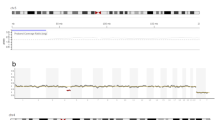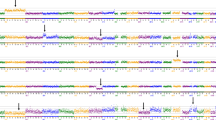Abstract
Purpose
To verify which genetic abnormalities prevent embryos to blastulate in a stage-specific time.
Methods
A single center retrospective study was performed between April 2016 and January 2017. Patients requiring Preimplantation Genetic Testing for Aneuploidies (PGT-A) by Next Generation Sequencing (NGS) were included. All embryos were cultured in a time-lapse imaging system and single blastomere biopsy was performed on day 3 of development. Segmental duplications and deletions as well as whole chromosome monosomies and trisomies were registered. Embryo arrest was defined if the embryo failed to blastulate 118 h post-injection. A logistic regression model was applied using the time to blastulate as the response variable and the different mutations as explanatory variables. A p value < 0.05 was considered significant.
Results
Of the 285 biopsied cleavage stage embryos, 103 (36.1%) were euploid, and 182 (63.9%) were aneuploid. There was a significant difference in the developmental arrest between euploid and aneuploid embryos (8.7% versus 42.9%; p = 0.0001). Segmental duplications and whole chromosome monosomies were found to have a significant effect on developmental arrest (p = 0.0163 and p = 0.0075), while trisomies and segmental deletions had no effect on developmental arrest. In case of segmental duplications, an increase of one extra segmental duplication increases the odd of arrest by 159%. For whole chromosome monosomies, the odd will only increase by 29% for every extra chromosomal monosomy. Both chromosomal abnormalities remained significant after adding age as an explanatory variable to the model (p = 0.014 and p = 0.009).
Conclusion
Day 3 cleavage stage embryos with segmental duplications or monosomies have a significantly decreased chance to reach the blastocyst stage.



Similar content being viewed by others
References
Jacobs PA, Hassold TJ. The origin of numberical chromosome abnormalities. Adv Genet. 1995;33:101–33. https://doi.org/10.1016/s0065-2660(08)60332-6.
Hassold T, Hunt P. To err (meiotically) is human: the genesis of human aneuploidy. Nat Rev Genet. 2001;2(4):280–91. https://doi.org/10.1038/35066065.
Rai R, Regan L. Recurrent miscarriage. Lancet. 2006;368(9535):601–11. https://doi.org/10.1016/S0140-6736(06)69204-0.
Hook EB, Hamerton JL. The frequency of chromosome abnormalities detected in consecutive newborn studies—differences between studies—results by sex and by severity of phenotypic involvement. In: Hook EB, Porter IH, Institute. NYSBD, editors. Population cytogenetics : studies in humans : proceedings of a Symposium on Human Population Cytogenetics sponsored by the Birth Defects Institute of the New York State Department of Health, held in Albany, New York, October 14–15, 1975 Birth Defects Institute symposia. New York: Academic Press, 1977.
Machin GA, Crolla JA. Chromosome constitution of 500 infants dying during the perinatal period: With an appendix concerning other genetic disorders among these infants. Hum Genet. 1974;23(3). https://doi.org/10.1007/BF00285104.
Grande M, Borrell A, Garcia-Posada R, Borobio V, Muñoz M, Creus M, et al. The effect of maternal age on chromosomal anomaly rate and spectrum in recurrent miscarriage. Hum Reprod. 2012;27(10):3109–17. https://doi.org/10.1093/humrep/des251.
Eiben B, Goebel R, Hansen S, Hammans W. Early amniocentesis--a cytogenetic evaluation of over 1500 cases. Prenat Diagn. 1994;14(6):497–501. https://doi.org/10.1002/pd.1970140615.
Jamieson ME, Coutts JR, Connor JM. The chromosome constitution of human preimplantation embryos fertilized in vitro. Hum Reprod. 1994;9(4):709–15. https://doi.org/10.1093/oxfordjournals.humrep.a138575.
Munné S, Lee A, Rosenwaks Z, Grifo J, Cohen J. Fertilization and early embryology: Diagnosis of major chromosome aneuploidies in human preimplantation embryos. Hum Reprod. 1993;8(12):2185–91. https://doi.org/10.1093/oxfordjournals.humrep.a138001.
Velilla E, Escudero T, Munné S. Blastomere fixation techniques and risk of misdiagnosis for preimplantation genetic diagnosis of aneuploidy. Reprod BioMed Online. 2002;4(3):210–7. https://doi.org/10.1016/S1472-6483(10)61808-1.
Northrop LE, Treff NR, Levy B, Scott RT. SNP microarray-based 24 chromosome aneuploidy screening demonstrates that cleavage-stage FISH poorly predicts aneuploidy in embryos that develop to morphologically normal blastocysts. Mol Hum Reprod. 2010;16(8):590–600. https://doi.org/10.1093/molehr/gaq037.
Almeida PA, Bolton VN. The relationship between chromosomal abnormality in the human preimplantation embryo and development in vitro. Reprod Fertil Dev. 1996;8(2):235–41. https://doi.org/10.1071/rd9960235.
Magli MC, Jones GM, Gras L, Gianaroli L, Korman I, Trounson AO. Chromosome mosaicism in day 3 aneuploid embryos that develop to morphologically normal blastocysts in vitro. Hum Reprod. 2000;15(8):1781–6. https://doi.org/10.1093/humrep/15.8.1781.
Sandalinas M, Sadowy S, Alikani M, Calderon G, Cohen J, Munné S. Developmental ability of chromosomally abnormal human embryos to develop to the blastocyst stage. Hum Reprod. 2001;16(9):1954–8. https://doi.org/10.1093/humrep/16.9.1954.
Munné S, Bahçe M, Sandalinas M, Escudero T, Márquez C, Velilla E, et al. Differences in chromosome susceptibility to aneuploidy and survival to first trimester. Reprod BioMed Online. 2004;8(1):81–90. https://doi.org/10.1016/s1472-6483(10)60501-9.
Rubio C, Rodrigo L, Mercader A, Mateu E, Buendía P, Pehlivan T, et al. Impact of chromosomal abnormalities on preimplantation embryo development. Prenat Diagn. 2007;27(8):748–56. https://doi.org/10.1002/pd.1773.
The Vienna consensus: report of an expert meeting on the development of ART laboratory performance indicators. Reprod BioMed Online. 2017;35(5):494–510. https://doi.org/10.1016/j.rbmo.2017.06.015.
La Marca A, Sunkara SK. Individualization of controlled ovarian stimulation in IVF using ovarian reserve markers: from theory to practice. Hum Reprod Update. 2014;20(1):124–40. https://doi.org/10.1093/humupd/dmt037.
Palermo G, Joris H, Devroey P, Van Steirteghem AC. Pregnancies after intracytoplasmic injection of single spermatozoon into an oocyte. Lancet. 1992;340(8810):17–8. https://doi.org/10.1016/0140-6736(92)92425-f.
Ciray HN, Campbell A, Agerholm IE, Aguilar J, Chamayou S, Esbert M, et al. Proposed guidelines on the nomenclature and annotation of dynamic human embryo monitoring by a time-lapse user group. Hum Reprod. 2014;29(12):2650–60. https://doi.org/10.1093/humrep/deu278.
Wells D, Kaur K, Grifo J, Glassner M, Taylor JC, Fragouli E, et al. Clinical utilisation of a rapid low-pass whole genome sequencing technique for the diagnosis of aneuploidy in human embryos prior to implantation. J Med Genet. 2014;51(8):553–62. https://doi.org/10.1136/jmedgenet-2014-102497.
Kung A, Munné S, Bankowski B, Coates A, Wells D. Validation of next-generation sequencing for comprehensive chromosome screening of embryos. Reprod BioMed Online. 2015;31(6):760–9. https://doi.org/10.1016/j.rbmo.2015.09.002.
Mertzanidou A, Wilton L, Cheng J, Spits C, Vanneste E, Moreau Y, et al. Microarray analysis reveals abnormal chromosomal complements in over 70% of 14 normally developing human embryos. Hum Reprod. 2013;28(1):256–64. https://doi.org/10.1093/humrep/des362.
Chow JF, Yeung WS, Lau EY, Lee VC, Ng EH, Ho P-C. Array comparative genomic hybridization analyses of all blastomeres of a cohort of embryos from young IVF patients revealed significant contribution of mitotic errors to embryo mosaicism at the cleavage stage. Reprod Biol Endocrinol. 2014;12(1):105. https://doi.org/10.1186/1477-7827-12-105.
Shi Q, Qiu Y, Xu C, Yang H, Li C, Li N, et al. Next-generation sequencing analysis of each blastomere in good-quality embryos: insights into the origins and mechanisms of embryonic aneuploidy in cleavage-stage embryos. J Assist Reprod Genet. 2020;37(7):1711–8. https://doi.org/10.1007/s10815-020-01803-9.
van Echten-Arends J, Mastenbroek S, Sikkema-Raddatz B, Korevaar JC, Heineman MJ, van der Veen F, et al. Chromosomal mosaicism in human preimplantation embryos: a systematic review. Hum Reprod Update. 2011;17(5):620–7. https://doi.org/10.1093/humupd/dmr014.
Wells D. Comprehensive chromosomal analysis of human preimplantation embryos using whole genome amplification and single cell comparative genomic hybridization. Mol Hum Reprod. 2000;6(11):1055–62. https://doi.org/10.1093/molehr/6.11.1055.
Janny L, Menezo YJ. Maternal age effect on early human embryonic development and blastocyst formation. Mol Reprod Dev. 1996;45(1):31–7. https://doi.org/10.1002/(SICI)1098-2795(199609)45:1<31::AID-MRD4>3.0.CO;2-T.
Barbash-Hazan S, Frumkin T, Malcov M, Yaron Y, Cohen T, Azem F, et al. Preimplantation aneuploid embryos undergo self-correction in correlation with their developmental potential. Fertil Steril. 2009;92(3):890–6. https://doi.org/10.1016/j.fertnstert.2008.07.1761.
Bazrgar M, Gourabi H, Valojerdi MR, Yazdi PE, Baharvand H. Self-correction of chromosomal abnormalities in human preimplantation embryos and embryonic stem cells. Stem Cells Dev. 2013;22(17):2449–56. https://doi.org/10.1089/scd.2013.0053.
Delhanty JD, Handyside AH. The origin of genetic defects in the human and their detection in the preimplantation embryo. Hum Reprod Update. 1995;1(3):201–15. https://doi.org/10.1093/humupd/1.3.201.
Evsikov S, Verlinsky Y. Mosaicism in the inner cell mass of human blastocysts. Hum Reprod. 1998;13(11):3151–5. https://doi.org/10.1093/humrep/13.11.3151.
Rubio C, Simon C, Vidal F, Rodrigo L, Pehlivan T, Remohi J, et al. Chromosomal abnormalities and embryo development in recurrent miscarriage couples. Hum Reprod. 2003;18(1):182–8. https://doi.org/10.1093/humrep/deg015.
Li M, DeUgarte CM, Surrey M, Danzer H, DeCherney A, Hill DL. Fluorescence in situ hybridization reanalysis of day-6 human blastocysts diagnosed with aneuploidy on day 3. Fertil Steril. 2005;84(5):1395–400. https://doi.org/10.1016/j.fertnstert.2005.04.068.
Munné S, Velilla E, Colls P, Bermudez MG, Vemuri MC, Steuerwald N, et al. Self-correction of chromosomally abnormal embryos in culture and implications for stem cell production. Fertil Steril. 2005;84(5):1328–34. https://doi.org/10.1016/j.fertnstert.2005.06.025.
Del Carmen Nogales M, et al. Type of chromosome abnormality affects embryo morphology dynamics. Fertil Steril. 2017;107(1):229–235.e2. https://doi.org/10.1016/j.fertnstert.2016.09.019.
Fragouli E, Alfarawati S, Spath K, Wells D. Morphological and cytogenetic assessment of cleavage and blastocyst stage embryos. Mol Hum Reprod. 2014;20(2):117–26. https://doi.org/10.1093/molehr/gat073.
Shahbazi MN, et al. Developmental potential of aneuploid human embryos cultured beyond implantation. Nat Commun. 2020;11(1):3987. https://doi.org/10.1038/s41467-020-17764-7.
Tiegs AW, Sun L, Patounakis G, Scott RT. Worth the wait? Day 7 blastocysts have lower euploidy rates but similar sustained implantation rates as day 5 and day 6 blastocysts. Hum Reprod. 2019;34(9):1632–9. https://doi.org/10.1093/humrep/dez138.
Ho JR, Arrach N, Rhodes-Long K, Salem W, McGinnis LK, Chung K, et al. Blastulation timing is associated with differential mitochondrial content in euploid embryos. J Assist Reprod Genet. 2018;35(4):711–20. https://doi.org/10.1007/s10815-018-1113-9.
Daphnis DD, Fragouli E, Economou K, Jerkovic S, Craft IL, Delhanty JDA, et al. Analysis of the evolution of chromosome abnormalities in human embryos from day 3 to 5 using CGH and FISH. Mol Hum Reprod. 2007;14(2):117–25. https://doi.org/10.1093/molehr/gam087.
Vanneste E, Voet T, le Caignec C, Ampe M, Konings P, Melotte C, et al. Chromosome instability is common in human cleavage-stage embryos. Nat Med. 2009;15(5):577–83. https://doi.org/10.1038/nm.1924.
Vera-Rodriguez M, Chavez SL, Rubio C, Pera RAR, Simon C. Prediction model for aneuploidy in early human embryo development revealed by single-cell analysis. Nat Commun. 2015;6(1):7601. https://doi.org/10.1038/ncomms8601.
Babariya D, Fragouli E, Alfarawati S, Spath K, Wells D. The incidence and origin of segmental aneuploidy in human oocytes and preimplantation embryos. Hum Reprod. 2017;32(12):2549–60. https://doi.org/10.1093/humrep/dex324.
Konstantinidis M, Milligan K, Berkeley AS, Kennedy J, Maxson W, Racowsky C, Munne S. Use of single nucleotide polymorphism (SNP) arrays and next generation sequencing (NGS) to study the incidence, type and origin of aneuploidy in the human preimplantation embryo. Fertility and Sterility. 2016;106(3):e22–e23. https://doi.org/10.1016/j.fertnstert.2016.07.076.
Verlinsky Y, Kuliev A. Preimplantation diagnosis for aneuploidies in assisted reproduction. Minerva Ginecol. 2004;56(3):197–203.
Voullaire L, Slater H, Williamson R, Wilton L. Chromosome analysis of blastomeres from human embryos by using comparative genomic hybridization. Hum Genet. 2000;106(2):210–7. https://doi.org/10.1007/s004390051030.
Liñán A, et al. Clinical reassessment of human embryo ploidy status between cleavage and blastocyst stage by next generation sequencing. PLoS One. 2018;13(8):e0201652. https://doi.org/10.1371/journal.pone.0201652.
Lawrenz B, el Khatib I, Liñán A, Bayram A, Arnanz A, Chopra R, et al. The clinicians´ dilemma with mosaicism—an insight from inner cell mass biopsies. Hum Reprod. 2019;34(6):998–1010. https://doi.org/10.1093/humrep/dez055.
Popovic M, Dhaenens L, Taelman J, Dheedene A, Bialecka M, de Sutter P, et al. Extended in vitro culture of human embryos demonstrates the complex nature of diagnosing chromosomal mosaicism from a single trophectoderm biopsy. Hum Reprod. 2019;34(4):758–69. https://doi.org/10.1093/humrep/dez012.
Pellestor F, Girardet A, Andréo B, Arnal F, Humeau C. Relationship between morphology and chromosomal constitution in human preimplantation embryo. Mol Reprod Dev. 1994;39(2):141–6. https://doi.org/10.1002/mrd.1080390204.
Tšuiko O, et al. Genome stability of bovine in vivo-conceived cleavage-stage embryos is higher compared to in vitro-produced embryos. Hum Reprod. 2017;32(11):2348–57. https://doi.org/10.1093/humrep/dex286.
Munné S, Nakajima ST, Najmabadi S, Sauer MV, Angle MJ, Rivas JL, et al. First PGT-A using human in vivo blastocysts recovered by uterine lavage: comparison with matched IVF embryo controls†. Hum Reprod. 2020;35(1):70–80. https://doi.org/10.1093/humrep/dez242.
Acknowledgements
The authors would like to thank Guillermo Mollá Robles and Alfredo T. Navarro Muñoz for the statistical analysis and Souraya Jaroudi for reviewing the manuscript.
Author information
Authors and Affiliations
Corresponding author
Ethics declarations
Competing interests
The authors declare no competing interests.
Additional information
Publisher’s note
Springer Nature remains neutral with regard to jurisdictional claims in published maps and institutional affiliations.
Rights and permissions
About this article
Cite this article
De Munck, N., Bayram, A., Elkhatib, I. et al. Segmental duplications and monosomies are linked to in vitro developmental arrest. J Assist Reprod Genet 38, 2183–2192 (2021). https://doi.org/10.1007/s10815-021-02147-8
Received:
Accepted:
Published:
Issue Date:
DOI: https://doi.org/10.1007/s10815-021-02147-8




